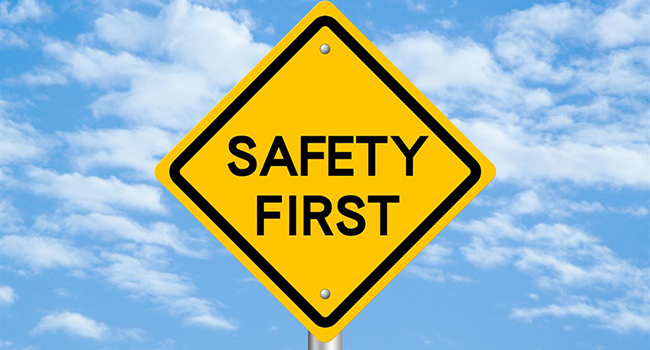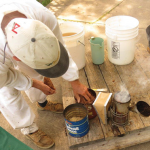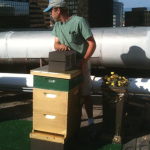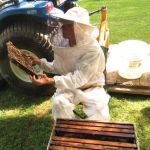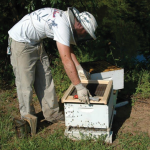By: David MacFawn
Safety in the Beeyard Best Practice is the first in a series of best practices developed for the South Carolina Beekeepers Association (SCBA) Master Beekeeping Program (MBP). Safety is considered the most important best practice.
- When approaching your beeyard, put your veil on. Stings to the eye may cause blindness. Protect your eyes. Keep bees out of your hair. If you have long hair, pull your hair back in a rubber band. The looser your hair, the easier to get a bee entangled in it if you take off your veil or it gets inside. If a bee does get in your veil, walk away from the beeyard before removing your veil.
-
Light your smoker. Smoke is what helps to control and calm your bees. There are two theories as to why smoke works. It interferes with the bees’ sense of smell, and shifts their behavior from colony defense to “gorge and retreat.” Don’t over smoke, but apply smoke any time that you see bees looking at you. If they are looking at you, they are aware of you! You want plentiful cool white smoke – gray smoke does not have the same effect on the bees. Hot smoke will burn the bees’ wings. Always check temperature of smoke – NEVER let flame rise higher than top of smoker. Do not use oils in your smoker that could potentially remain in the hive comb. Be mindful of fire safety when lighting your smoker and during use especially during dry periods or when dry vegetation might be close to your working area.
- Wear clothing that is light-colored and loose-fitting.
- Avoid wearing fuzzy clothing, especially dark fuzzy socks. Bees tend to sting at the elastic interface where clothing meets your skin.
- Medical
- Hydration; In the Summer, make sure you hydrate prior to work and have extra water for frequent breaks.
- First Aid Kit in vehicle with antihistamine. and Epi-pen for possible allergic reactions. Always know where the closest medical facility is located.
- Travel
- Outyards: let someone know where you are located.
- Have a cell phone available.
- Properly secure equipment in trucks.
- Properly enclose smoker and “cork” the flue, or extinguish before travel.
- If in an area where Africanized bees are present park car or truck close enough to provide emergency sheltering.
-
Avoid eating bananas prior to working your bees. The smell of bananas is similar to the bees’ alarm scent. Be careful about wearing products with perfumes or colognes. Bees communicate using pheromones or scents. Introducing a strange scent could cause problems: attraction, aggression, confusion.
- Clean your hive tool to kill diseases like American Foulbrood (AFB) spores. This can be done by placing your hive tool in a lit smoker. This is a good practice to establish between hives, especially between beeyards.
- Wash your bee suit on a regular basis to avoid contamination of diseases like AFB and to remove alarm pheromone. Think biosecurity when moving from one bee yard to another by cleaning your tools, changing or washing your suit and your boots.
- Prior to work, scan apiary and remove trip hazards such as sticks, fallen branches, vines, and brambles.
- Avoid standing in front of the hive. Stand to the side or back of the hive out of the bees’ flight path.
-
Be gentle. Move slowly without any quick jerking movements. The more bees you squash, the more alarm pheromone is released and the more excited your bees will become. During a nectar flow you can work faster but during a dearth the bees are more defensive and you should work slower.
- Work the colony earlier in the day when the field bees are foraging. The field bees are more apt to sting. If you have to work later, move slower.
- If you have a drone layer colony, you will have mostly older bees that are more apt to sting.
- Small colonies are less apt to sting than large colonies.
- Do not wear sunglasses or leather watch bands.
- Do not jar the hive or bump your smoker on the woodenware at the hive entrance when puffing a couple smoke puffs into the entrance prior to opening the hive.
- Place hives on individual stands, two cement blocks work well, to keep noise and vibrations from exciting adjacent colonies.
- Get in and out of hives quickly. In a ten-frame hive remove frames two or nine first – not one or 10. Frames one and 10 are typically stuck to the outside wall with propolis. When replacing frames, align the Hoffman spacers on the frame you are inserting with the Hoffman spacers on the frames in the hive. This will help from squashing bees or rolling a queen that you did not see.
-
When lifting, ‘bend with your knees, not your back’, and put your hives lower so you can kneel while working. Bending over for long periods of time or lifting wrong may hurt your back.
- Don’t place your hives where they can be seen or regarded as a nuisance Be aware of pools, foot paths, schoolyards, playgrounds, and livestock.
- Be aware of potential pesticide applications nearby.
- Also remember bears like honey too.
- Weather considerations. Work bees on sunny days whenever possible. Rainy days will have many bees in the hive and more older bees which tend to be more defensive. Even after a rain shower many bees will stay in the hive so if possible delay your inspection. Bees don’t like foraging when it is windy outside. Again, try to postpone inspections until the wind is low.






